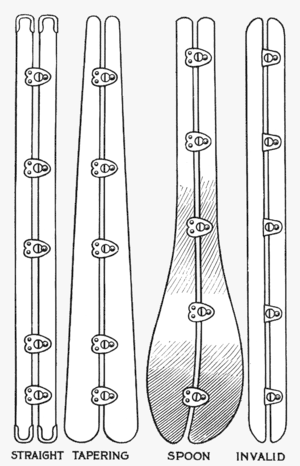Busk
A busk (also spelled busque) is a rigid element of a corset at the centre front of the garment.[1] Two types exist, one- and two-part busks.[2]

Single-piece busks were used in corsets typically worn up to the nineteenth centuries (such as "stays") and were intended to keep the front of the corset straight and upright. They were typically made of wood, ivory, or bone slipped into a pocket and tied in place with a lace called the busk point.[3] These busks were often carved and decorated, or inscribed with messages, and were popular gifts from men to their sweethearts.
In the middle of the nineteenth century, a new form of busk appeared. It was made of two long pieces of steel, one with loops and the other with posts, that functioned in the same way as hook and eye fastenings or buttons on a garment. [4] This made corsets considerably easier to put on and take off, as the laces did not have to be loosened as much as when the corset had to go over the wearer's head and shoulders. The second half of the nineteenth century also saw the invention of the spoon busk.[5]
References
- Regular busk
- What is a corset busk? in The Corset Channel
- Stay busk from a 1788 Stay or Corset in BBC A history of the world
- https://web.archive.org/web/20130917060145/http://farthingalescorsetmakingsupplies.com/busks.php
- From The Corset: A Cultural History by Valerie Steele. 208 pag. Yale University Press (2003). ISBN 978-0300099539

